Was there really a rattlesnake that grew longer than a giraffe’s neck? Yep! And it was a fat one, too, weighing over 30 pounds.
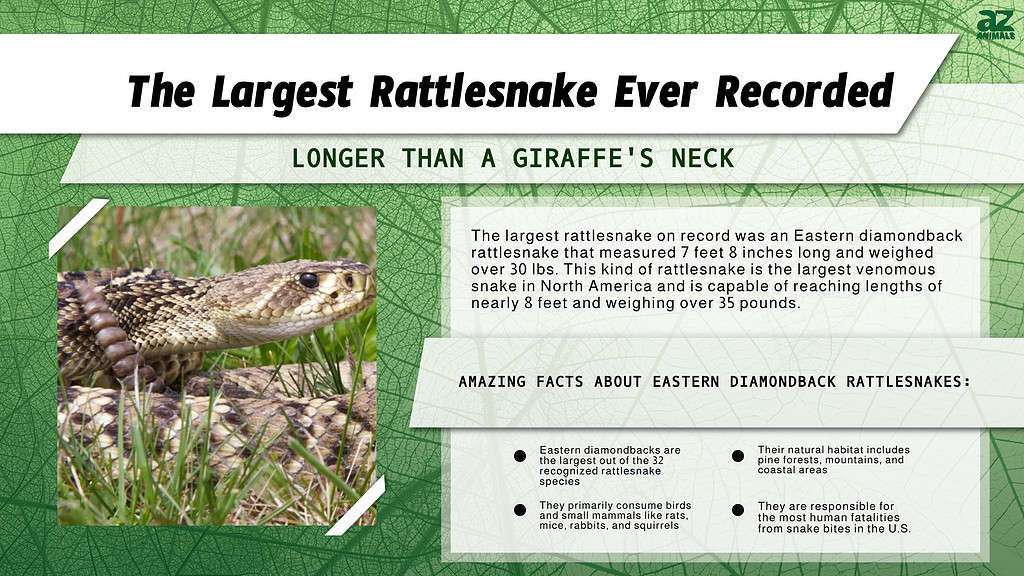
Eastern diamondback rattlesnakes are the largest venomous species in North America, and they have a big appetite. When there’s enough food, these snakes can reach impressive lengths of up to 8 feet or even longer.
How big was the world’s largest eastern diamondback? Follow along as we learn all about this monstrous snake, where it lived, and how it grew so big.
Fun Facts About Eastern Diamondback Rattlesnakes
- Eastern diamondbacks are the largest out of the 32 recognized species.
- The biggest rattlesnake was 7 feet 8 inches long.
- They can reach lengths of nearly 8 feet and weigh over 35 pounds.
- They have large fangs that can grow up to an inch long.
- Their natural habitat includes pine forests, mountains, and coastal areas.
- Eastern diamondbacks don’t have natural predators and can grow exceptionally large.
- They primarily feed on small mammals and birds like rats, mice, rabbits, and squirrels.
- Rattlesnakes need to eat at least once every two weeks, but the frequency depends on the size of the meal.
- Rattlesnakes use their venom and defensive musk when they feel threatened but are not generally aggressive toward humans.
Largest Rattlesnake Ever
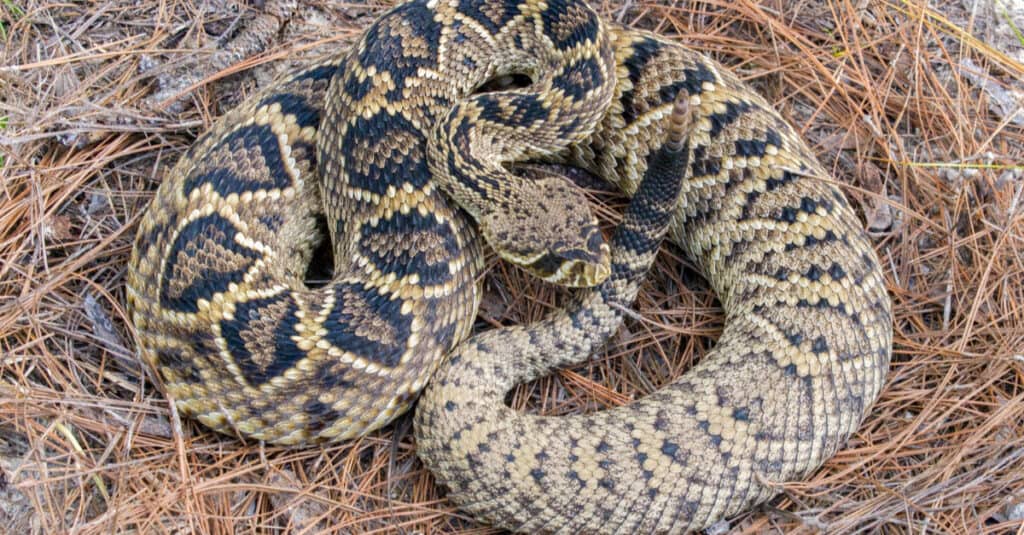
The largest rattlesnake ever was an eastern diamondback rattlesnake measuring 7 feet 8 inches long.
©Chase D’animulls/Shutterstock.com
The largest rattlesnake ever was an eastern diamondback rattlesnake measuring 7 feet 8 inches long. This behemoth holds the record for the biggest rattlesnake ever recorded.
The eastern diamondback is the largest venomous snake in North America. It’s also the largest of all recognized rattlesnakes, of which there are 32 species.
Eastern diamondbacks can reach lengths of nearly 8 feet and weigh over 35 pounds. This snake species possesses large fangs that can grow up to an inch long! Its natural habitat includes pine forests, mountains, and dry marsh and coastal areas of Florida and the lower southeastern United States. These snakes live in every Florida county and reside in nearshore islands. You can even find rattlesnakes in the Florida Keys and several islands in the Gulf of Mexico.
How Did It Grow So Large?
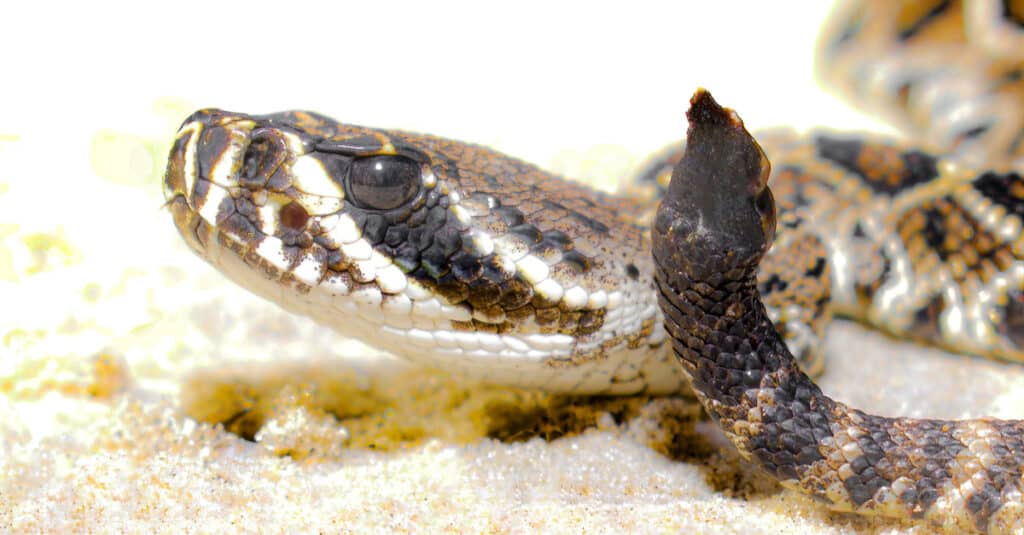
Eastern diamondbacks are born weighing less than a pound but can grow over 15 pounds.
©Chase D’animulls/Shutterstock.com
As the largest rattlesnake species in the world, it’s common for eastern diamondback rattlesnakes to reach typically 5.5 feet in length and weigh 15 pounds. But every now and then, a specimen far exceeds these numbers. So, how did the eastern diamondback shot in 1946 measure 7.8 feet long and weigh 34 pounds?
Here are the top 3 reasons the snake grew so big:
- Food availability
- Lack of predators
- Need to feed
Eastern diamondbacks don’t have any natural predators. When you add in their efficient hunting skills, the massive size makes sense. It’s easy to reach ridiculously big sizes when you’re the biggest, baddest, and most hungry animal around.
How Rattlesnakes Hunt: Ambush Predation
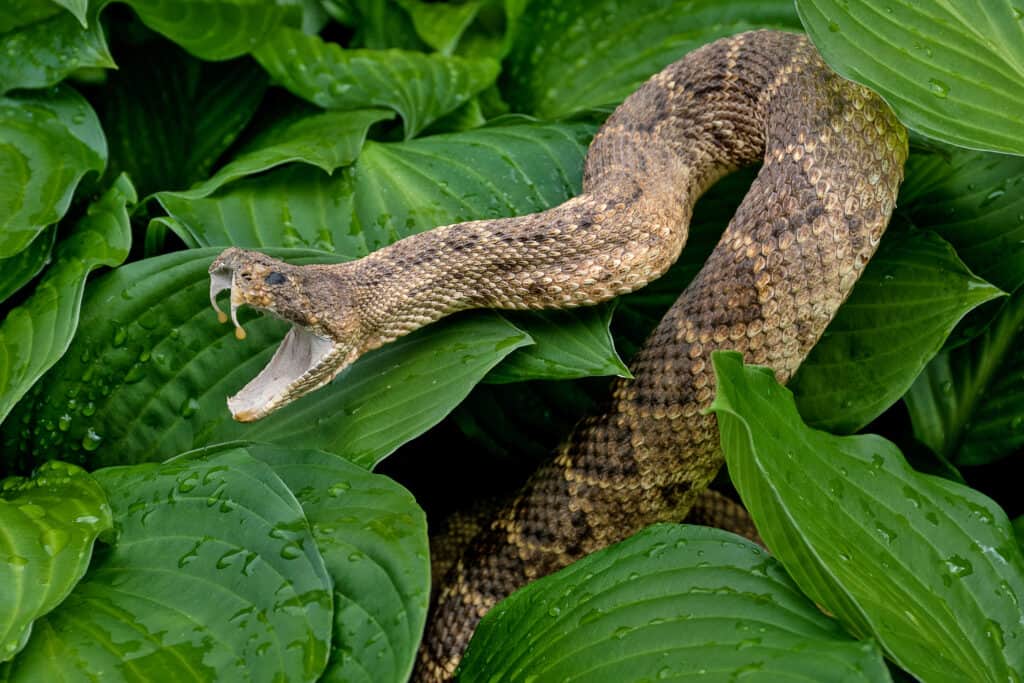
Rattlesnakes are ambush predators who wait for the right moment to strike.
©Maria Dryfhout/Shutterstock.com
How does a rattlesnake catch enough food to grow over 7 feet long?
Here are some of the strategies rattlesnakes use when hunting:
- Ambush predation
- Heat-detecting capabilities
- Hunting at night
Rattlesnakes can accurately identify their prey in darkness thanks to heat-sensing pits. Their brain combines heat and visual images to make a mental map. This skill is thanks to a special sensory organ called a pit organ.
Eastern diamondback rattlesnakes have a temperature-sensitive membrane with around 40×40 sensory cells. They can see at a wide angle of about 100 degrees. The pit organ works like an infrared camera. The neural map in the rattlesnake’s brain represents the shape and layout of the outside world.
What Do Rattlesnakes Eat?
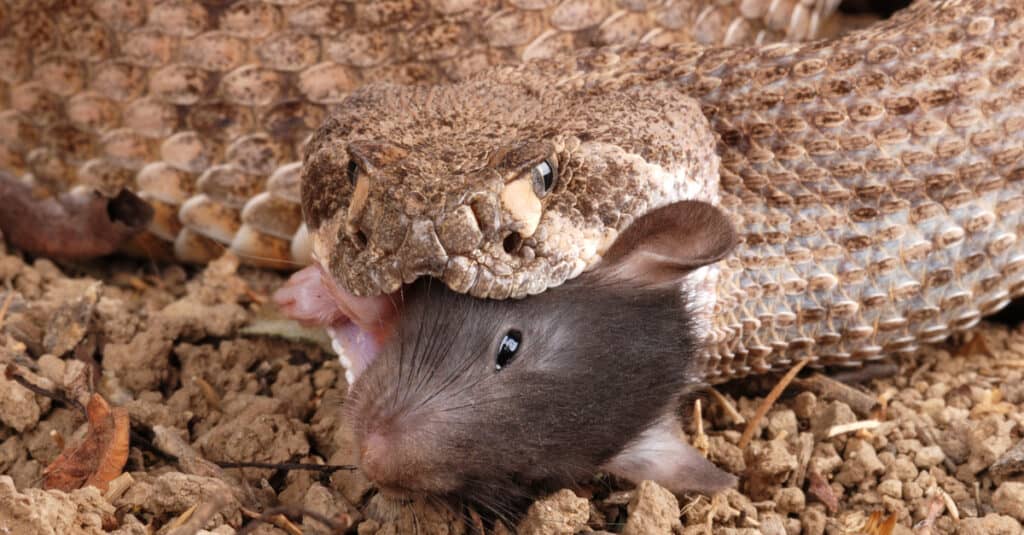
Mice, squirrels, and small birds are all a part of the rattlesnake’s diet.
©Audrey Snider-Bell/Shutterstock.com
What did the world’s largest rattlesnake eat to grow so big? Lots of birds and tasty mammals.
The eastern diamondback mainly feeds on small mammals and birds. They also eat rats, mice, rabbits, squirrels, and more. These skilled ambush hunters locate prey by scent as well as by sensing the heat of warm-blooded animals. After stalking their prey, they launch a surprise attack, striking to kill. Once they kill an animal, these snakes don’t waste any time chowing down.
How often did the world’s biggest rattler need to eat? The National Wildlife Federation can help us answer this question! Their records indicate these snakes need to dine at least once every two weeks. But that doesn’t mean they’re on a strict feeding schedule.
The frequency of feeding depends on the size of the meal and the snake. If all they catch is a few mice, the rattler might still be on the lookout for another bite to eat. But if they just finished eating a gigantic rabbit, it could be a couple of weeks before another hunt.
Since the world’s largest rattlesnake was 34 pounds, chances are it was on a weekly or even daily feeding schedule. This big snake was likely eating a lot of squirrels and rabbits to reach its massive size.
The Truth About Venom
All it takes is one bite from one of these snakes to produce deadly results. But that doesn’t mean snakes are out to get you. In fact, the opposite is true.
Snakes generally leave humans alone if not provoked, but they will attack if they feel threatened. These reptiles aren’t aggressive, but they will defend themselves.
Rattlesnakes use their rattle, made of keratin, as a warning system. The notorious sound lets animals know to stay away! If their warnings aren’t listened to, rattlesnakes defend themselves by using their venom. They also have a defensive musk that comes in handy.
There’s a common misunderstanding that baby rattlers have more venom, but this isn’t true. Whether it’s an adult or a baby, a single bite from the eastern diamondback can deliver as much as 450 mg of venom. It takes less than 150 mg for a bite to be potentially lethal to humans. Western diamondback rattlesnakes can deliver bites with venom ranging from 250 to 350 mg and occasionally up to 800 mg.
Rattlesnake Rattles As Squirrel Skin
Fun fact; each time a rattlesnake sheds its skin, it adds a rattle segment. The shed rattles come in handy for squirrels trying not to get eaten. Squirrels use shed rattlesnake skin to coat themselves and appear less attractive to predators.
Edgar: The Giant Albino Eastern Diamondback Rattlesnake
Did you hear about Edgar, the albino eastern diamondback rattlesnake? Although he passed away at the age of 21, his legend still lives on, especially among those at the Orianne Center for Indigo Conservation (OCIC).
Edgar, the albino rattlesnake, was born on September 8, 2001. He came to the OCIC from the Central Florida Zoo and soon began growing larger than anyone thought possible!
The baby snake grew to over 7 feet in length and weighed more than 20 pounds, making him one of the largest on record. The OCIC described Edgar as the easiest animal to manage in their venomous snake collection, rarely sounding his rattle.
He served as an ambassador for all snake species, especially rattlesnakes. Edgar’s impressive size and interaction with visitors played a big role in teaching people about what snakes are really like.
More Types of Rattlesnakes
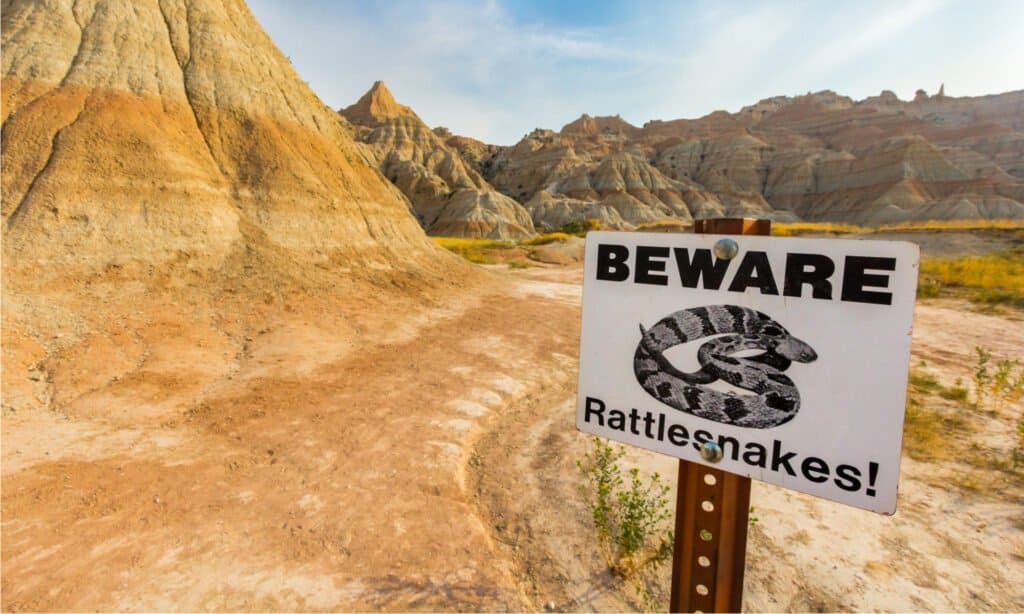
Find out what rattlesnakes you might encounter on a hike and take the right precautions.
©MrDinger/Shutterstock.com
The eastern diamondback rattlesnake is just the start! Along with the world’s largest rattlesnake species, there are also all sorts of other fascinating snakes slithering around.
Here’s a list of the top rattlesnake species you should be aware of:
- Western Diamondback
- Eastern Diamondback
- Timber Rattlesnake
- Sidewinder
- Mojave
- Black-Tailed Rattlesnake
- Prairie Rattlesnake
- Southwestern Speckled Rattlesnake
- Santa Catalina Island Rattlesnake
Ways to Help Rattlesnakes
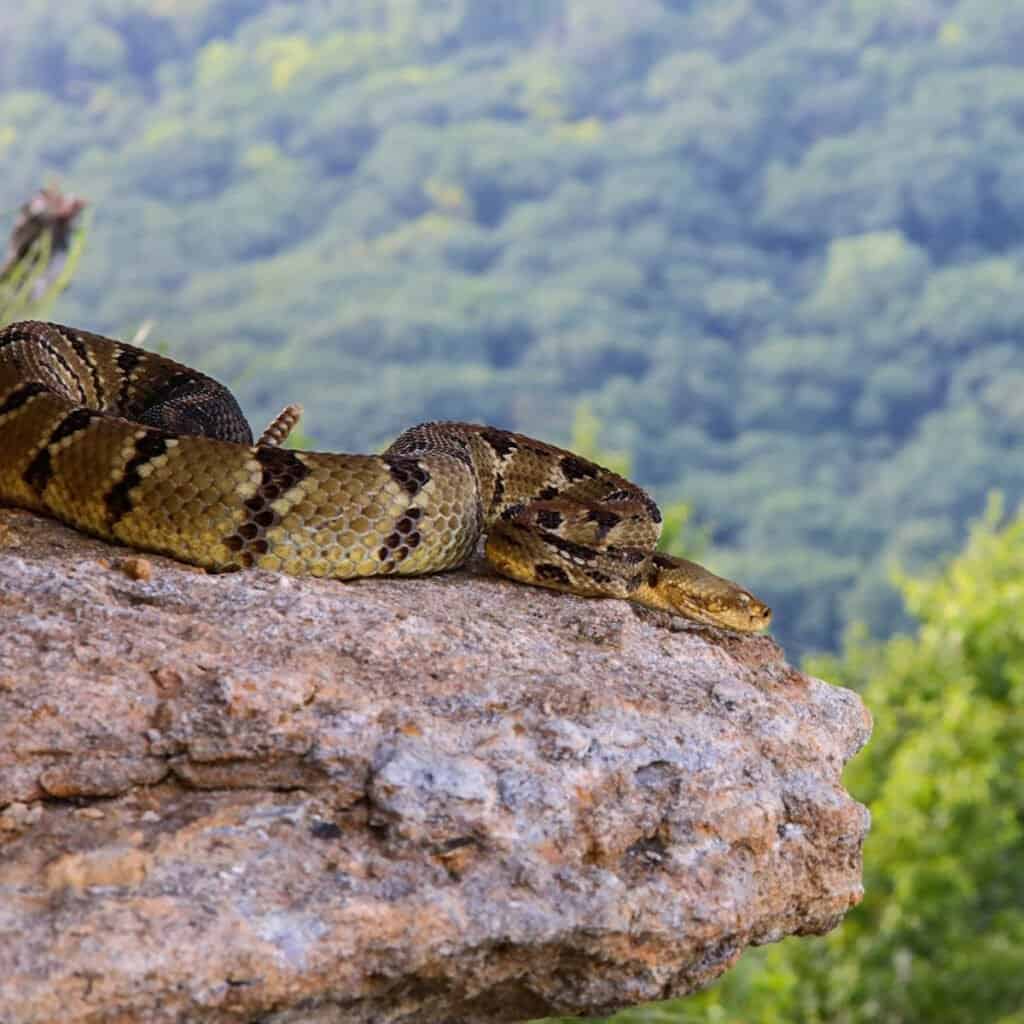
Rattlesnakes are fascinating creatures we can help conserve through habitat management.
©bradenjalexander/Shutterstock.com
How can you help the rattlesnakes? By learning how to handle an encounter safely. For starters, give rattlesnakes space and avoid handling them. When you hear the rattle, don’t investigate. Instead, choose a different direction to hike in.
Be aware of your surroundings. Stay cautious while in areas where snakes are present; watch your step and keep dogs on a short leash. Always report rattlesnake sightings using the appropriate channels. You can contact local authorities or organizations for snake safety questions or concerns.
Unfortunately, eastern diamondbacks are in decline throughout their range. But there’s hope. Habitat management and restoration, including prescribed fires, are crucial for conservation.
Another ray of hope is the way people are beginning to see these snakes in a new light. Rattlesnake roundups are transitioning into conservation festivals. These family-friendly events help raise awareness about a fascinating species that can be misunderstood. Additionally, there’s a lot of ongoing research focused on the species’ response to human behaviors, climate change, and environmental factors.
The photo featured at the top of this post is © iStock.com/Wide-River-Rick
Discover the "Monster" Snake 5X Bigger than an Anaconda
Every day A-Z Animals sends out some of the most incredible facts in the world from our free newsletter. Want to discover the 10 most beautiful snakes in the world, a "snake island" where you're never more than 3 feet from danger, or a "monster" snake 5X larger than an anaconda? Then sign up right now and you'll start receiving our daily newsletter absolutely free.
Thank you for reading! Have some feedback for us? Contact the AZ Animals editorial team.






